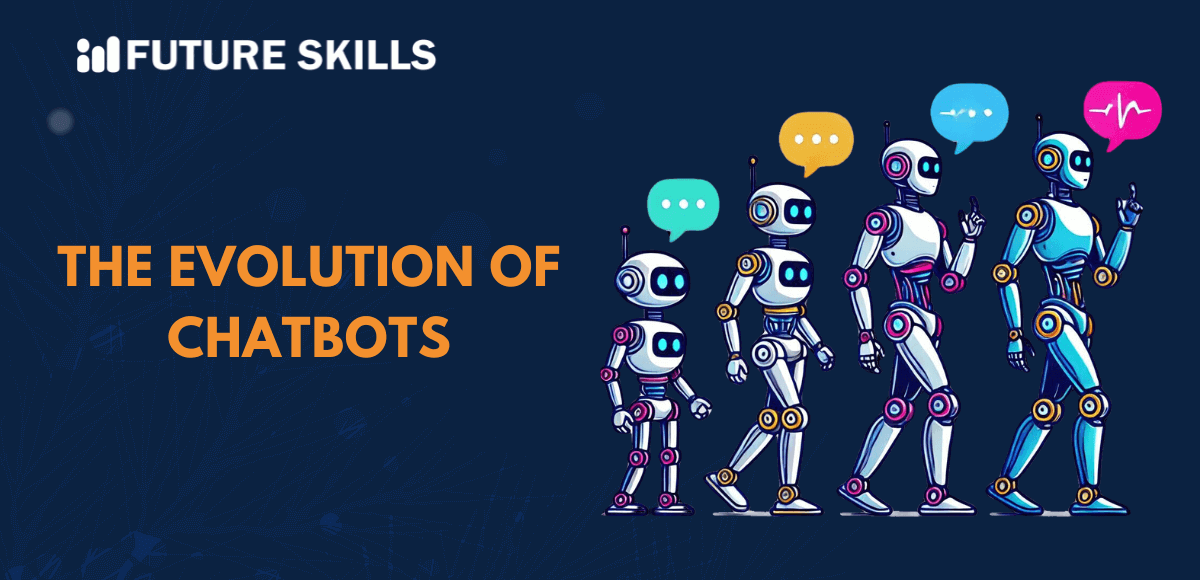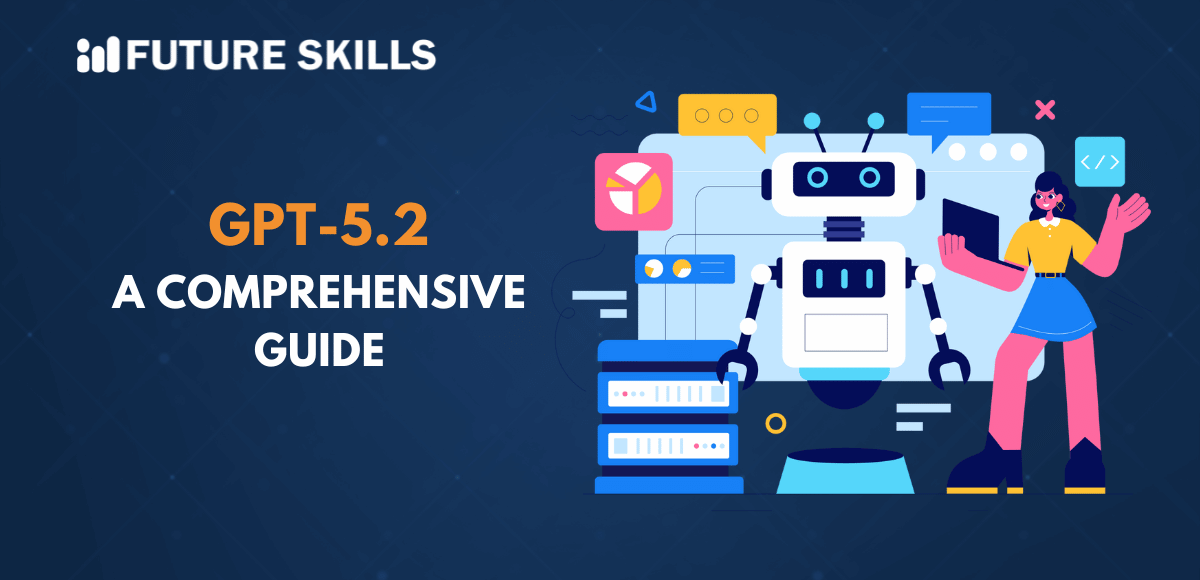Chatbots are one of the notable examples of how technology has transformed our lives. The earliest chatbots were designed only for understanding and responding to basic instructions. The progress in machine learning and natural language processing fuelled the evolution of chatbots into sophisticated programs that can support complex conversations. Artificial intelligence has been the core element behind the changing perceptions of people about technology.
The growth of chatbots from ELIZA to ChatGPT has been a remarkable journey. It is important to learn about the important milestones that have turned chatbots into digital partners for different tasks. The advancements in each new chatbot that came after ELIZA can also help you predict how chatbots might grow in future. Let us learn more about chatbots and their history to understand their implications for the real world.
Become a certified ChatGPT expert in just 4 weeks with our Certified ChatGPT Professional (CCGP)™ Certification. Enroll today!
Understanding the Significance of Chatbots
Chatbots are computer programs that can generate text in natural language like humans. The primary factors that have been responsible for driving enhancements in chatbots are natural language processing and artificial intelligence. These components enable chatbots to replicate human-like conversation and offer desired responses to users. The advantages of chatbots revolve primarily around their ability to mimic human conversations.
In the history of chatbots, you will find some prominent players that have brought the concept of human-machine conversations closer to reality. ELIZA was created as the first example of empowering machines to talk with humans. The recent examples of advanced chatbots such as ChatGPT have moved beyond the conventional capabilities by introducing new features. For example, chatbots can be always available for applications like customer service.
Chatbots are significant tools to help users make the most of AI technology in different areas. Apart from improvements in customer service, chatbots powered by AI can help you set reminders on your smartphones or modify certain settings. You must have come across some examples of chatbots while shopping on ecommerce websites that offer any type of assistance you need from the store. The rise of chatbots as a prominent application of artificial intelligence creates new avenues for embedding AI in our daily lives and business operations.
How Did Chatbots Come a Long Way from ELIZA to ChatGPT?
Anyone who uses the internet must have interacted with chatbots at some point of time. The arrival of ChatGPT changed the ways in which you can interact with chatbots with the power of AI and NLP making interactions more human-like. Traditional chatbots that arrived before ChatGPT did not have the smart capabilities that offered highly engaging experiences to users. Let us go through the most important milestones that have shaped up the lineage of chatbots.
-
ELIZA
The story of chatbots began with ELIZA in 1966 at MIT. Joseph Weizenbaum is the one responsible for writing the ELIZA chatbot history as he created the first ever chatbot. He created ELIZA with the goal of exploring possibilities for advancements in natural language processing to improve human-machine interaction. The most popular implementation of ELIZA involved simulation of a therapy session between a virtual psychiatrist and users.
Users can type their questions or statements and the ELIZA chatbot would respond by using pre-programmed replies. ELIZA leveraged substitution methodology and pattern matching for simulating human-like conversation albeit with the lack of true intelligence. The chatbot offered a conversational experience without learning anything new and responding according to a pre-defined set of responses. However, the impact of ELIZA has extended beyond its initial purpose as many researchers used it as a reference for advancements in conversational AI.
-
PARRY
The next milestone for chatbots came in the 1970s with PARRY that blended artificial intelligence and computer science. The primary objective of the chatbot was to ensure simulation of a person suffering from paranoid schizophrenia. It helped researchers with the functionalities to navigate through the intricate mazes of human behavior and psychology.
The answers to queries like ‘What is the history of chatbot?’ would describe PARRY as a different version of ELIZA. PARRY was different as it simulated the behavior of a patient with a specific backstory and personality. The most striking capability of the chatbot was the closeness to human interactions with its massive collection of pre-programmed scenarios and databases. Users could talk to PARRY about different topics while emulating the symptoms of schizophrenia.
PARRY was a valuable tool for understanding the complexities of mental illness and dynamics of human communication albeit with some ethical concerns. It created questions about the potential implications for users after interactions with a simulation of schizophrenia. Experts argued that prolonged exposure to PARRY can have a negative effect on certain individuals. Even with its specific limitations, PARRY played a major role in fuelling the growth of AI and chatbot technology.
-
Racter
You must have found many articles on generative AI as it is an important trend in the world of AI. Racter is the first ever chatbot that introduced the possibilities for establishing the foundation of generative AI. It arrived in 1983 and offered a unique approach that was different from the two popular chatbots. The chatbot was created to simulate the actions of writers that can create original prose and talk about literature.
Racter is an important predecessor to ChatGPT history as it was the first to explore the capabilities of computers for generating coherent and compelling content. Racter used a unique ‘pragmatic-driven’ text generation approach for generating text according to specific rules. It was an experiment that presented a groundbreaking approach to the use of AI in text generation. The popularity of Racter did not last long as it ultimately faded away with the rise of advanced AI technologies.
-
Smarter Chatbots
The era of smarter chatbots arrived in 1990 and continued till 2000 with some popular mentions like ALICE, Cleverbot and SmarterChild gaining popularity. ALICE offered more coherent responses as compared to the earlier chatbots albeit with the risks of coming up with absurd responses in some cases. SmarterChild is also another example of smart chatbots that provided rudimentary games, weather forecasts and sports scores. The quirky interface of SmarterChild appealed to millions of users worldwide and became an instant hit.
While ALICE and SmarterChild had to experience some limitations, the next addition among smarter chatbots introduced a huge difference. Cleverbot was probably the first chatbot that claimed to use AI for learning from interactions with users. The truth of the claims by Cleverbot remains under doubt till now while users enjoyed it as a favorite pastime.
-
Voice Assistants
The world witnessed another major milestone in the evolution of chatbots with the introduction of voice assistants. Siri, Google Assistant and Alexa are the best examples of virtual voice assistants that introduced interactive communication between machines and humans. Voice recognition technology helped in enhancing the conversational capabilities of virtual assistants and allowed users to enjoy natural interactions with machines. You could just ask a voice assistant to check the weather forecasts for the day or set an important reminder with a conversational interface like interacting with chatbots.
-
Introduction of ChatGPT
The course of chatbot history took a major turn in 2022 when OpenAI brought ChatGPT into the market. OpenAI had started the journey of developing ChatGPT with the mission to build the foundations of artificial general intelligence or AGI. The involvement of major players in the tech industry has enabled OpenAI to push the boundaries of research on AI chatbots. OpenAI made an important advancement with the release of Generative Pre-trained Transformer or GPT language model.
GPT provided a major boost to ChatGPT history as it could generate text in natural language according to prompts. It provided the foundations for developing new and advanced versions that led to the release of ChatGPT. The arrival of ChatGPT encouraged the development of other chatbots such as DALL-E and LAMDA for different tasks.
Build a career in AI as a prompt engineer with our accredited Prompt Engineering Certification Course and take your career to new heights of success.
Do Chatbots Have Any Limitations?
The review of chatbot history showed that many prominent chatbots have emerged over the course of time since ELIZA. You can understand that the continuous advancements in chatbots have led to promising advantages for users. However, chatbots also have certain limitations such as technical risks, cost and concerns of reliability in complex situations. Chatbots have to depend on technology that can create technical risks such as misinterpretation of user queries.
Understanding the history of AI and chatbots can serve as valuable insights on how each new iteration addressed the setbacks in previous chatbots. You cannot depend on chatbots in complex situations that require in-depth knowledge of certain topics. However, new chatbots have been emerging with the capabilities to learn from their experiences and serve users in the best way.
Final Thoughts
The evolution of chatbots shows that AI has come a long way from following simple instructions to self-learning capabilities. ELIZA introduced chatbots to the world by simulating the capabilities of a psychiatrist albeit with a rudimentary design. The subsequent chatbots tried to replicate ELIZA before the arrival of smarter chatbots and voice assistants. With the arrival of ChatGPT, the design of chatbots is now incomplete without AI and natural language processing technologies. Learn more about AI chatbots and how you can use them to your advantage now.







